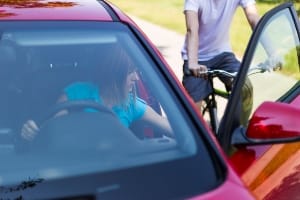Many people ride their bicycles for transportation, exercise and leisure. No matter why bicyclists are out on the road, drivers need to understand cyclists’ rights on Pennsylvania roads to prevent accidents and liability.
Table of Contents
If you were involved in a cyclist accident due to someone else’s negligence, you may be able to seek compensation. We can determine your legal options in a free consultation.
At Schmidt Kramer, our Harrisburg car accident lawyers accept car accident cases on contingency. This means we only get paid if we help you secure compensation.
Call today to schedule your free case review: (717) 727-2500.
What Do I Need to Know About Bike Lanes?

Harrisburg and other Pennsylvania cities have implemented bike lanes to improve cyclist safety and traffic flow. Proper use and awareness of bike lanes can significantly reduce the risk of accidents between drivers and cyclists.
Drivers need to know these rules for bike lanes.
- Lane Boundaries: Drivers cannot drive, park or stop in bike lanes, unless they are turning, parking or avoiding other traffic.
- Yield to Cyclists: Drivers making a right turn must let cyclists in the bike lane go first.
- Contra-Flow Bike Lanes: Some one-way streets have bike lanes allowing cyclists to travel in the opposite direction. Always check for oncoming cyclists before turning onto or crossing roads.
- Full Lane Usage: People often think cyclists must ride on the far-right side of the road. However, they can use the full lane when needed. For example, they could use the entire lane to avoid road obstacles or prepare for a left turn.
- Passing Cyclists Safely: When drivers pass cyclists, they must allow at least four feet of clearance. If there is not enough room to pass safely, drivers must wait until it is safe.
What Are Cyclists’ Rights at Intersections and Turn Signals?
Intersections are hotspots for cyclist-driver collisions. Clear communication and adherence to traffic laws are essential for safety.
Cyclists can take the following actions at intersections to stay safe.
- Hand Signals: Cyclists are required to use hand signals when turning or changing lanes. This helps communicate their movements to other road users.
- Traffic Signal: Cyclists must obey all traffic signals and signs. If a traffic light does not detect a bike, the cyclist can treat the red light like a stop sign. They need to yield to all other traffic before going through the intersection.
- Right Turns: When making a right turn, cyclists should stay as close to the right-hand curb or edge of the road as possible.
- Left Turns: Cyclists can use the left lane when preparing for a left turn. They should signal their intention to turn and move to the left lane when it is safe.
- Crosswalks: While cyclists can ride across crosswalks, walking the bike across the street is safer.
- Inoperable Signals: If a traffic signal is malfunctioning or does not detect the bicycle, cyclists can treat it as a stop sign when red.
Are Cyclists Required to Wear Helmets in Pennsylvania?
In Pennsylvania, bike riders under 12 are required to wear helmets, but adults are not obligated to do so.
Although wearing a helmet for safety purposes is recommended, it is not legally required. If a cyclist is not wearing a helmet during an accident, that cannot be used to dismiss the driver’s liability.
Pennsylvania Laws on Dooring Accidents
“Dooring” occurs when a driver or passenger opens a car door into the path of an oncoming cyclist. This could leave cyclists with severe injuries and damages.
Drivers and cyclists should know the following about dooring accidents:
- Check for Cyclists: Pennsylvania law requires vehicle occupants to check for approaching traffic, including bicycles, before opening car doors.
- Liability for Dooring: If a cyclist is injured due to dooring, the person who opened the door may be liable for damages.
- Safe Zone for Opening Doors: Drivers and passengers could use the “Dutch Reach” method to prevent dooring accidents. This method involves opening the door with the hand farthest from it, forcing your body to turn, making it easier to spot approaching cyclists.
How Can Cyclists Ride More Safely at Night?
In Pennsylvania, cyclists who ride at night must have specific equipment and take steps to ensure they are visible.
- Use Lights: A white front light and a red rear reflector or light are required for night riding. Drivers should look for these lights, which may not be as bright or noticeable as car headlights.
- Reflective Gear: While not legally required, many cyclists wear reflective clothing to stay visible.
- Reflective Tape: Adding reflective tape to your bike frame and helmet can help you to be seen from different angles.
- Route Planning: Choose well-lit routes with lower traffic volumes. Stick to routes you know well to avoid unexpected challenges or hazards.
Injured in an Accident Involving a Cyclist? Contact Schmidt Kramer
If you are injured in a cyclist accident, seek legal guidance. At Schmidt Kramer, we understand Pennsylvania laws and have decades of experience securing compensation for our clients.
Find out what your legal options are during a free consultation. We do not charge any upfront costs or fees. Our firm works on a contingency basis, so we only get paid if we win your case.
Get answers to your legal questions today. (717) 727-2500.

